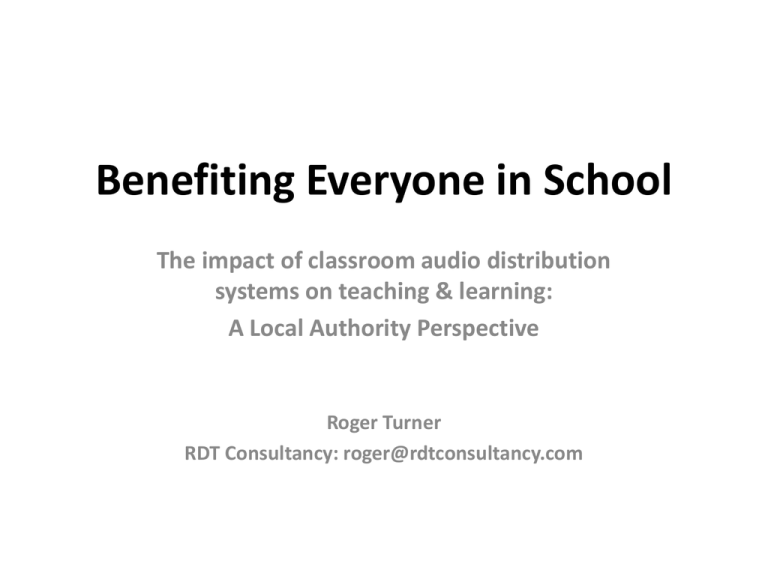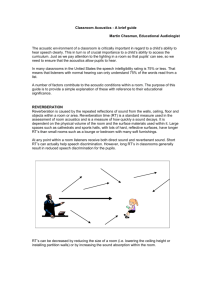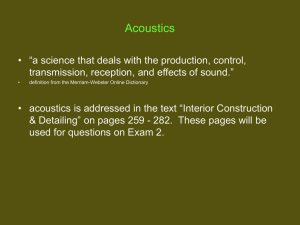Benefiting Everyone in School
advertisement

Benefiting Everyone in School The impact of classroom audio distribution systems on teaching & learning: A Local Authority Perspective Roger Turner RDT Consultancy: roger@rdtconsultancy.com The Benefits of Classroom Audio Distribution Systems Aural Neural Development & Language Knowledge Distance & Noise pollution (+15 dB SNR) Hearing impaired (30%) [NDCS & BATOD] Dialogic Teaching Speech Intelligibility SEN All ESOL On-task behaviour Which Learners? Why Learners? Self-confidence BENEFITS OF CADS Classroom Management & Efficient use of Lesson Time Why Teachers? Voice welfare (Clinics) Absence & Supply Teachers Even distribution of intelligible speech and all other sound sources Wireless / Portable Integrates multimedia & systems for hearing impaired 5-year guarantee Age of building Size of teaching spaces Classroom Acoustics Quality CABE Solutions Infrared NXT Technology RF Cone Technology Cost & Immediacy Acoustic Materials Why Learners? “Talk has always been one of the essential tools of teaching, and the best teachers use it with flair. But talk is much more than an aid to effective teaching. Children, we now know, need to talk, and to experience a rich diet of spoken language, in order to think and learn. Reading, writing and numeracy may be the acknowledged curriculum ‘basics’, but talk is arguably the true foundation for learning.” Towards Dialogic Teaching (2010): Prof Robin Alexander, Director Cambridge Primary Review Why Learners? Barriers to understanding • neural immaturity • limitations of vocabulary • distance from teacher • noise pollution / signal/noise ratio • audibility and intelligibility • lack of consonance clarity resulting in pupils inability to close/complete words and understand sentences • mild to severe hearing loss (30%+ on a typical day) Why Learners? Research • The MARRS Project (1979 – 1994) • Crandell and Smaldino (1995) • Leavitt and Flexer (1991) • Rosenberg (2004) • Flexer (2002) • McCarty and Ure (2003) • Chelius (2004) • Shields & Dockrell(2008) Teachers’ judgements Statement % My students were able to hear and understand me better 91.4 The pace my students learnt increased 78.9 My students demonstrated an increased ability to follow directions 80.9 My students’ attention skills improved and the CAT system helped hold their attention 84.2 The CAT system improved my ability to control and manage the classroom. 70.7 I experienced a decrease in the need to repeat directions and information 74.1 My students benefited from using the microphone 76.9 Pupils’ Judgements Statement I was able to hear and understand my teacher better The pace at which I learned increased My English skills improved more quickly My confidence improved when I used the student microphone I achieved better grades It would be beneficial if all my classrooms had amplification systems % 70 (70) 51 (54) 46 (52) 39 (45) 42 (44) 64 (67) Why Learners? Preliminary investigation (2011) • Typical American primary schools classroom (8.23m long x 8.13m wide x 4.6m high) • Very close to ANSI recommended classroom acoustics standards • Placed a Redcat in the classroom on alternate days • Used LENA technology to collect and then analyse all sound source material • Result: Without Redcat approx 10,000 intelligible words per day / With Redcat approx 15,000 words per day. Dan Ostergren: Research & Consulting Audiologist Which Learners? “Making a mainstream school more inclusive will create advantages for all the children taught there. For example, an amplification system provided in all classrooms (called a sound field system) will specifically assist children with hearing impairment, and will also help audibility for all other children. It sends a clear message that all children are equal, regardless of their needs, encouraging greater understanding and tolerance throughout the whole school community.” Creating Excellent Primary Schools (2010): CABE Which Learners? “Because hearing loss is invisible, the negative results of poor acoustic accessibility and/or unmanaged hearing loss of any degree (behavior problems, attention problems, spoken language difficulty, reading, and academic deficiencies) are erroneously believed to stem from causes other than hearing loss.” (2011) Carol Flexer, Distinguished Prof Emeritus, Univ. of Akron & NW Ohio Which Learners? “Children with language disabilities have auditory processing problems with common consonant-vowel combinations that are spoken quickly. The children have trouble hearing them accurately and, as a result, reproducing them accurately.” (1999) Michael Merzenich: Prof Emeritus of Neuroscience, UCLA) Which Learners? Pupils with SEN who benefit • hearing impairment • speech and language processing difficulties • attention deficit disabilities • behavioural problems • developmental disabilities • other sensory impairment • a lack of self-confidence • EAL Why Teachers Teacher’s health & well-being • many suffer voice strain and loss of voice • absence as a result of sore throats • pupils taught by supply teachers • schools incur high supply teacher costs • the cost of purchasing CADS technology recovered from reduced supply teacher costs. • teachers with vulnerable voices retained in the profession Why Teachers? Teacher benefits • an ability to more quickly settle pupils • give instructions, ask and answer questions, give feedback etc. once • engage pupils in work more quickly • a calmer, more industrious working atmosphere • use their voice with much greater variety of expression and character • increase usable lesson time • increased energy throughout the day Classroom Acoustics Criteria affecting student achievement • Human Comfort – i.e., temperatures within the human comfort range • Indoor Air Quality – i.e., appropriate ventilation and filtering systems • Lighting • Acoustical Control Prioritisation of 31 Criteria for School Building Adequacy (2004) Glen Earthman: Prof. Emeritus, Virginia State University “A number of studies have demonstrated a positive correlation between appropriate acoustical conditions and student achievement. Good research indicates students simply do not learn when they can not hear well. As simplistic as this statement sounds, numerous students suffer through school in buildings that are too noisy for them to learn properly, yet nothing is done about it. The ability to clearly hear in the classroom is vital for student learning and teacher performance.” (2004) Glen Earthman: Prof. Emeritus, Virginia State University Classroom acoustics suffer from: • low public & Government concern • insufficient school capital funding targeted at the quality of teaching and learning environment (only 13% focused on scenery and classroom settings) • value engineering during the build or refurbishment stage where educationalists are not included • the creation of many large and very large teaching spaces • a severe reduction in the new Government’s school capital funding budget and in school budgets for the upkeep of schools • no funding for ICT in new school building contracts More positively • It appears that the Government will require new school buildings to meet good acoustics standards in line with BB93 • Classroom audio distribution systems are a highly cost effective way of achieving higher acoustic standards than BB93 at a time when capital funding is scarce. More positively • CADS are now: – easy to install with some systems being completely mobile – using NXT technology to ensure even voice distribution with no dead areas – using high frequencies bands that optimise speech intelligibility – instantly controllable through volume control microphones – able to integrate all other sound sources including computers, CDs, i-pods, interactive whiteboards etc – fully compatible with specialist hearing aids – of very high quality, aesthetically attractive, with comfortable light-weight microphones and high reliability with some systems now providing 5 year guarantees.









